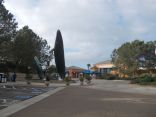- Bahamas
- Bermuda
- Canada
- Costa Rica
- Cuba
- Curaçao
- Dominican Republic
- Guadeloupe
- Guatemala
- Mexico
- Trinidad & Tobago
-
USA
- Alabama
- Alaska
- Arizona
- Arkansas
-
California
- Carlsbad */**
- Escondido */**
- Fresno
-
La Jolla */**
- Long Beach */**
- Los Angeles */**
- Monterey Bay */**
- Oakland *
- Palm Desert
- Sacramento *
- San Diego Seaworld */**
- San Diego Zoo */**
- San Francisco Aquarium */**
- San Francisco Museum */**
- San Francisco Zoo */**
- San Pedro */**
- Santa Barbara
- Santa Monica *
- Vallejo
- Colorado
- Connecticut
- District of Columbia
- Florida
- Georgia
- Hawaii
- Idaho
- Illinois
- Indiana
- Iowa
- Kansas
- Kentucky
- Louisiana
- Maryland
- Massachusetts
- Michigan
- Minnesota
- Mississippi
- Missouri
- Nebraska
- Nevada
- New Jersey
- New Mexico
- New York
- North Carolina
- North Dakota
- Ohio
- Oklahoma
- Oregon
- Pennsylvania
- Rhode Island
- South Carolina
- South Dakota
- Tennessee
- Texas
- Utah
- Virginia
- Washington
- Wisconsin
Birch Aquarium

http://aquarium.ucsd.edu/
Opened 1903
City: La Jolla
Country: USA
State: California
Species 380
Enter the world of sharks, seahorses, living coral reefs and more, and discover a stunning variety of Pacific marine life in more than 60 habitats. Interact with exhibits that showcase the cutting-edge discoveries of Scripps Oceanography explorers through hands-on displays and multimedia.
Vis stort kort
Birch Aquarium at Scripps
2300 Expedition Way
La Jolla
CA 92037
USA
Phone nr 858-534-3474
Open minimum 9am-5pm
Entrance fee
- Adult 24,95 Dollars
- Child 19,95 Dollars
Annual card
- Adult 74,- dollars
- 2 Adults 99,- dollars
- Family* 179,- dollars
*Family cards are valid for 2 adults in the same household and up to 2 children, each additional child is 10$
There are several daily feeding shows, for the time please ask at the till station.
History:
Scripps was formed in 1903 when UC Berkeley zoologist William E. Ritter joined community leaders such as newspaper tycoon E.W. Scripps, philanthropist Ellen Browning Scripps, and physician Fred Baker to charter the Marine Biological Association of San Diego, predecessor to today's institution. That summer Ritter conducted a field session in marine biology at a temporary location in the boathouse of the Hotel Del Coronado. By 1905, the researchers had outgrown the modest laboratory and moved to a small laboratory at La Jolla Cove that cost $992 to build. The Little Green Lab, named for its color, featured the insitition's first public aquarium exhibit. Two years later, the association purchased for $1,000 more than 170 acres of pristine property at La Jolla Shores from the City of San Diego at a public auction. The first permanent building at the site designed by architect Irving Gill housed the aquarium on the first floor and the oceanographic museum in an upstairs lecture hall. Today, this building, the George H. Memorial Marine Biological Laboratory, is listed on the National Register of Historic Places and houses Scripps's graduate education office. In 1915, the first building devoted solely to an aquarium was built on the Scripps campus in La Jolla, California. The small, wooden structure contained 19 tanks ranging in size from 96 to 228 gallons. The museum was housed on the ground floor of a nearby building. Plans for a new aquarium were delayed until after World War II. The Scripps Aquarium-Museum opened in 1951 and named to honor former institution director T. Wayland Vaughan. The three-story facility served the institution for more than 40 years as Scripps Oceanography's window to the ocean world. A ring of 18 tanks, the largest at 2,000 gallons surrounded a central museum of glass exhibit cases displaying Scripps research projects. Within a month of its opening, visitors from all 48 states had signed the guest book. A fund-raising effort for a larger aquarium-museum kicked off in 1986 when the Stephen and Mary Birch Foundation donated $6 million to the new facility. In total, $10 million was raised for construction and initial exhibits. Birch Aquarium at Scripps opened on Sept. 16, 1992 atop a picturesque bluff overlooking the Pacific Ocean and Scripps Oceanography campus.
DE: Diese Aquarium zeigt die artenviefallt von Kalifornien und Baja Califonia aber auch mehrere Arten von Haie. Er versucht auch auf verschiedenen wegen verschiedene energiverbrauch zu zeigen und wie man eher diese umweltfreundluch machen kann
DK: Dette akvarie viser artsmangfoldigheden af Californien og Baja California. , samt forskellige arter hajer. Akvariet forsøger også på forskellig vis at vise forskellige energiformer og hvordan disse kan gøres mere grønne